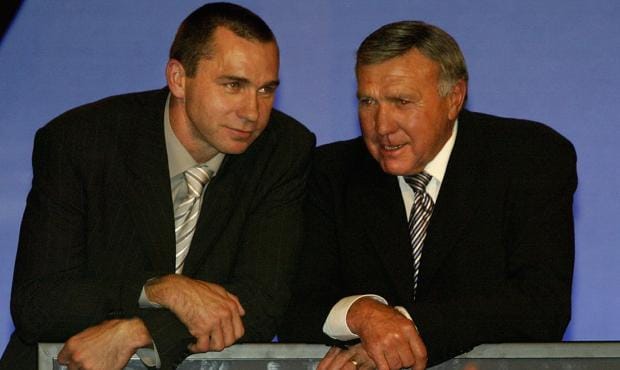Over the club’s 140-year history, South Melbourne/ Sydney Swans players have claimed 14 Brownlow Medals, the most of any club in VFL/AFL history.
At tonight’s Sydney Swans Guernsey Presentation and Hall of Fame dinner, presented by Volkswagen, the club’s ‘Brownlow Factory’ was one of four items added to the club’s Heritage List.
The club has produced an impressive 11 individual winners over the years, including two multiple winners of the coveted individual honour.
Bloods Legend Bob Skilton took out the prestigious award in 1959, 1963 and 1968, while Adam Goodes won the Brownlow Medal in 2003 and 2006.
Individual Brownlow Medallists included Herbie Matthews (1940), Ron Clegg (1949), Fred Goldsmith (1955), Peter Bedford (1970), Graham Teasdale (1977), Barry Round (1981), Greg Williams (1986), Gerard Healy (1988) and Paul Kelly (1995).
Five of the club’s Brownlow winners - Skilton, Goodes, Kelly, Healy and Bedford - were in attendance at Friday night’s event, and took to the stage together in recognition of their achievements.

Other items added to the club’s Heritage List tonight were:
Players Lost at War
South Melbourne players who lost their life fighting for their country were also recognised at Friday night’s event.
A century on from the beginning of World War I, the club paid tribute to those players who were among 60,000 Australians who never came home.
Players who had either represented the club or were playing at the time of their enlistment who lost their lives were Norman Bradford, Hugh Callan, Fred Fielding, Charles Fincher, Jack Freeman, Edward Harrison, Claude Thomas, Jack Turnbull and the brilliant Bruce Sloss, who was judged Champion of the Colony in 1911.
The Second World War lasted from 1938 to 1945 with an estimate of 50 to 85 million fatalities. Australia entered the conflict in September 1939 and by the end of World War II, one million Australians had served in the Armed Forces with 27,000 killed and another 24,000 injured.
South Melbourne players who lost their lives in World War II were Alf Hedge, Norman Le Brun, Alan Pearsall, Gordon Sawley, Jack Shelton, Jack Wade and Len Thomas.
The 1933 Jumper
It was a new-look Bloods in 1932, when the team took to the field in a new jumper.
For the first time, the club donned a white guernsey with a red V, a red collar and the long-sleeved guernseys featured red cuffs, which replaced the white jumper with a red sash that was previously worn by the club.
The players’ numbers were red, and the socks were hooped red and white. Black shorts were worn at home and white shorts for away matches.
The jumpers were made of wool and were exceptionally heavy compared to the lightweight, state-of-the-art uniforms the players wear today.
While no one can say with certainty that the new jumper played a role, the club managed to break their decade-long finals drought in 1932, and went on win the premiership in 1933.
The club played in four successive grand finals from 1933 to 1936 donning the white jumper with the red V, so it could be said that the new guernsey signalled the beginning of a new era for the Bloods.
30 Goals in Three Consecutive Weeks
The Sydney Swans’ big goal hauls of 1987 have been added to the club’s Heritage List.
In rounds 16 to 18, the Swans wrote their names into the history books when they booted over 30 goals in three successive matches.
On July 19, 1987, Sydney defeated West Coast 30-21 (201) to 10-11 (71) at the SCG. This included a second quarter in which the Swans kicked 12.4. Stevie Wright kicked eight goals, while fellow midfielder Barry Mitchell kicked three. Warwick Capper kicked five and Team of the Century wingman David Murphy booted four.
The Swans put on a show the following week at the SCG when the team defeated Essendon 36.20 (236) to 11.7 (73). This included a massive 13-goal last quarter for the Swans. Capper kicked six goals, Wright five and eventual Best and Fairest winner, Gerard Healy finished the match with four.
The Swans’ big score against the Bombers was also a historic moment for the club, with Sydney becoming the first team in League history to score over 200 points in consecutive games.
The following week the Swans defeated Richmond 31-12 (198) to 15-17 (107). Capper and Merv Neagle each kicked five goals, while Tony Morwood kicked four. Some familiar names were amongst the Swans’ best included Dennis Carroll, Rod Carter, Craig Holden and Morwood.
The Swans remain the only team in history to achieve the feat of kicking more than 30 goals in three consecutive matches, and given the nature of today’s game it seems unlikely it will happen again.


